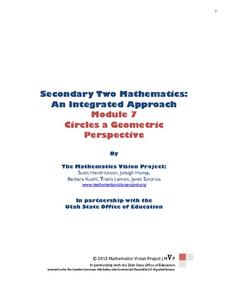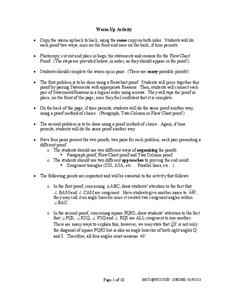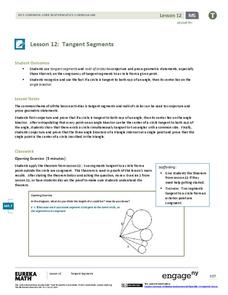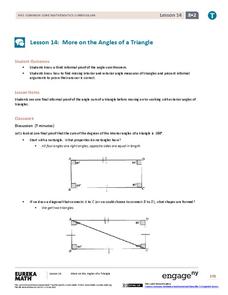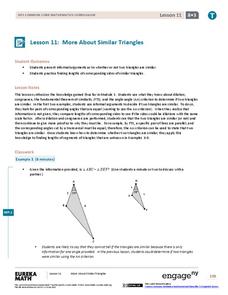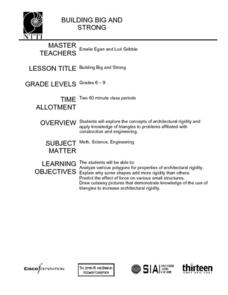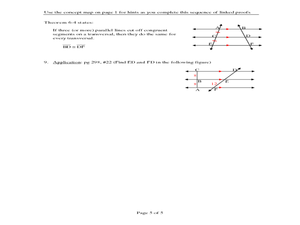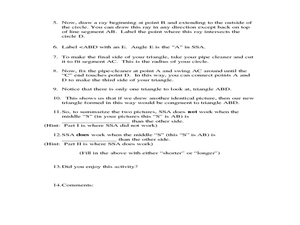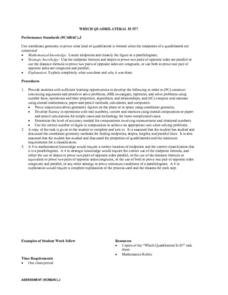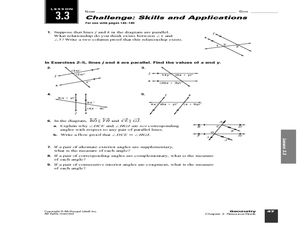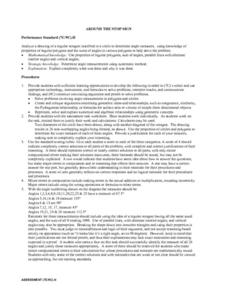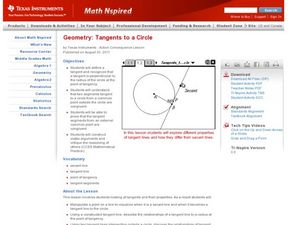Mathematics Vision Project
Circles: A Geometric Perspective
Circles are the foundation of many geometric concepts and extensions - a point that is thoroughly driven home in this extensive unit. Fundamental properties of circles are investigated (including sector area, angle measure, and...
Virginia Department of Education
Similar Triangles
Pupils work in pairs to investigate what it takes to prove that two triangles are similar. They work through various shortcuts to find which are enough to show a similarity relationship between the triangles. Small groups work with the...
West Contra Costa Unified School District
Investigating Special Right Triangles
Scholars first investigate relationships in the side lengths of 30°-60°-90° triangles and 45°-45°-90° triangles. This knowledge then helps them solve problems later in the lesson plan about special right triangles.
EngageNY
Tangent Segments
What's so special about tangents? Learners first explore how if a circle is tangent to both rays of an angle, then its center is on the angle bisector. They then complete a set of exercises designed to explore further properties and...
EngageNY
More on the Angles of a Triangle
Angles and triangles: they're all connected. Uncover the connections between angles in triangles. Scholars learn how to find both exterior and interior angle measures in triangles. The lesson emphasizes the vocabulary related to these...
EngageNY
More About Similar Triangles
Determine whether two triangles are similar. The lesson plan presents opportunities for pupils to find the criterion needed to show that two triangles are similar. Scholars use the definition of similarity to find any missing side...
Virginia Department of Education
Inductive and Deductive Reasoning
Introduce pupils to the two types of reasoning, inductive and deductive. Classmates work in pairs or small groups to learn the difference between the two and apply these reasonings to develop valid conclusions.
Curated OER
Building Big and Strong
Middle and high schoolers explore the concepts of architectural rigidity. They analyze a variety of polygons, and explain why some shapes add more strength to structures than others. The PBS video, "Building Big," is utilized in this plan.
Curated OER
Logical Relationship of Postulates & Theorems
In this postulates and theorems instructional activity, students explore a concept map containing information about angles and sides, alternate interior angles, and diagonals of a parallelogram. They use the concept map to prove...
Curated OER
Why Doesn't SSA Work?
Students investigate the relationship between angles and their sides. In this geometry instructional activity, students prove why SSA does not work as a true angle side relationship theorem.
Curated OER
Investigating AAS
Young scholars investigate the theorems of ASA, AAS, AAA and ASA. In this geometry lesson, students discuss the theorems of triangles and how it is used to solve for missing sides or angles. They review how two angles are formed by two...
Curated OER
Which Quadrilateral Is It?
Young scholars prove conjectures about geometric figures on the plane or in space using coordinate geometry. They develop fluency in operations with real numbers, vectors and matrices using mental computation or paper-and-pencil...
Curated OER
Regular Polyhedra
Tenth graders investigate the history of geometry and its different shapes. In this geometry lesson, 10th graders practice seeing three dimensional shapes and explain why there are only five polyhedra. They relate all the new materials...
Curated OER
Challenge: Skills and Applications Lesson 3.3
In this angle measures instructional activity, students solve 9 short answer problems. Students find values for x and y given two parallel lines cut by a transversal. Students use alternate interior, supplementary, and exterior angles to...
Curated OER
Around The Stop Sign
Students analyze a drawing of a regular octagon inscribed in a circle to determine angle measures, using knowledge of properties of regular polygons and the sums of angles in various polygons to help solve the problem. They use...
Curated OER
Parallel and Perpendicular Lines
Tenth graders explore parallel and perpendicular lines. In this geometry lesson, 10th graders investigate the relationships associated with parallel lines and transversals, perpendicular lines, and the angles formed by these...
Curated OER
Angles and Parallel Lines Homework
In this geometry worksheet, students identify the angles formed by parallel lines and a transversal. They differentiate between the angles of a transversal and that of a perpendicular line. There are 14 questions.
Curated OER
Tangents to a Circle
Pupils construct tangent lines. In this geometry lesson plan, students identify the point of tangency, secant and tangent lines. They graph the lines on the Ti and make observations.
Curated OER
Isosceles Triangles
Students identify the properties of an isosceles triangle. In this geometry activity, students find the midpoint, median and angle bisector of a triangle. They construct angle bisectors and measure missing angles.
Curated OER
Geometry
In this geometry worksheet, students identify the different shapes created by nets. They also identify the intersection of lines and planes. There are 5 questions with an answer key.
Curated OER
Parallel-o-Home
Students investigate the usage of parallel and perpendicular shapes in the real world. In this geometry lesson, students investigate shapes for properties that are related to the real world. They relate all the properties of shape tot he...
Curated OER
Polygons All Around Us!
Students explore the concept of polygon properties. In this polygon properties lesson plan, students draw polygons with different numbers of sides such as pentagons, octagons, hexagons, etc. Students identify different geometric shapes...
Pennsylvania Department of Education
Creating Polygons
Students describe, make and compare polygons. In this creating polygons activity, students identify properties of quadrilaterals and describe common features of two dimensional shapes.
Curated OER
Angles Lesson Plan
Students stud angles, and then play the "What's Your Angle?" game. They complete at least 10 computer generated problems from the Angles Applet.


